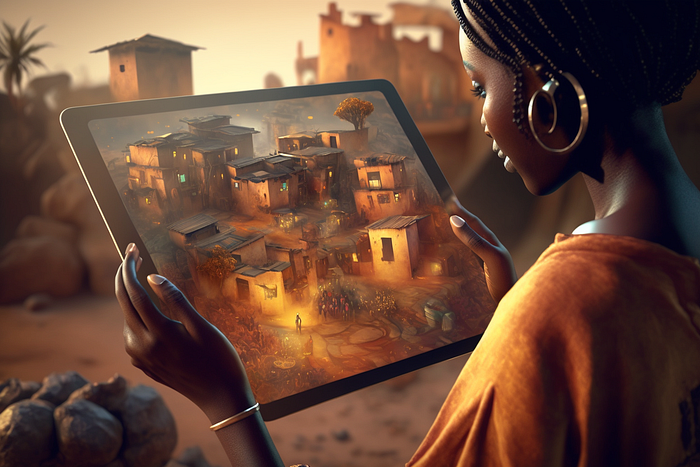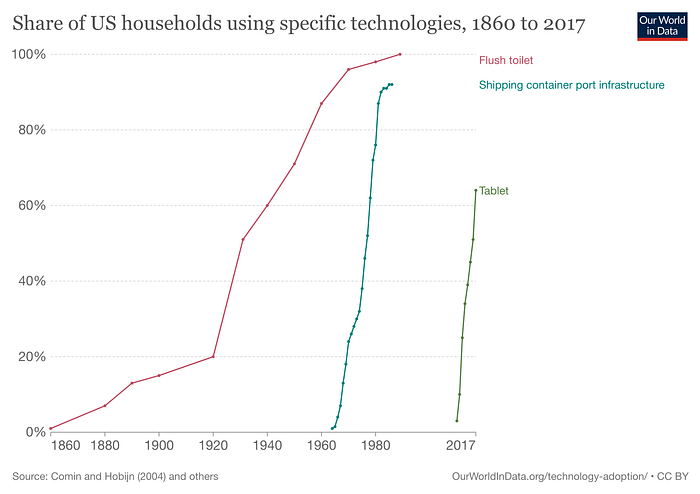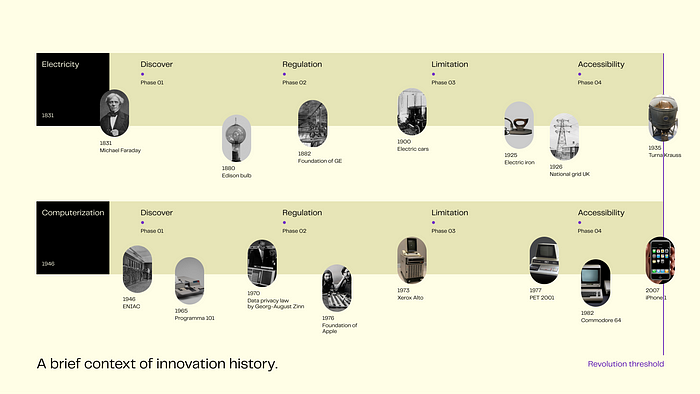

Made for 5 billion people
source link: https://uxdesign.cc/made-for-5-billion-people-1db9d2074cfb
Go to the source link to view the article. You can view the picture content, updated content and better typesetting reading experience. If the link is broken, please click the button below to view the snapshot at that time.
Made for 5 billion people
How we can empower humans to contribute to a better world through Generative AI

African woman plans her future village made in MidJourney by Timo Wagner
What if 5 billion people had the opportunity to contribute to a better world? What if they could shape solutions to their own challenges?
This or something similar could be a scenario in the coming years, guided by the technical possibilities of AI. Generative AI tools are far more than just a technical achievement; they are, above all, an expression of a new kind of globalization. Communication is moving back into the focus of human networking. And never before has this networking been accessible to so many people with such simplicity.
The speed of accessibility
The doors of accessibility generally seem to open faster for us today.
It took over 80 years for 60% of Americans to have access to a flush toilet. It took just 14 years to make existing American ports infrastructurally accessible to container ships. And it took just 7 years for 60% of Americans to own a tablet. We see this form of accessibility compression in almost every area.

comparison of different technologies and their shares: flush toilet, shipping container port, tablet
In just 20 years, we were able to minimize the cost of sequencing a complete human genome by 210,00 times. From $95,260,000 to $454. These milestones tell us two things: More stable infrastructures allow innovations to be made accessible to the general public more quickly. And a more efficient cost structure creates another metamorphosis in accessibility.
And it is precisely these better infrastructures and more cost-efficient devices that have led to a 13,000% increase in the number of Internet users on the African continent since the turn of the millennium. 21 times faster than in Europe.
It feels like déjà vu
Somehow, it’s all been there before. These innovations. These hypes manifested themselves as trends and later as things that could no longer be imagined without. In 1804, Joseph-Marie Jacquard developed a mechanical loom based on punch cards. And also at that time like today, people feared for their jobs. Weavers feared being unemployed soon by automatism without ever seeing the chance of this technical achievement. Henry Prevost Babbage saw this chance 85 years later (respectively his father decades before). The punched card established by Jacquard formed the cornerstone of today’s binary systems: 0 and 1. There or not there. And on this foundation stone, Babbage developed a punch card-controlled calculating machine. He built a bridge of analogy.
And somehow they were already there, rolling through our streets: Electric cars. In 1888, the first electric car was developed: the Flocken Elektrowagon. Far before Tesla and other brands shaped today’s image of future electrified urban environments. In 1900, the share of electrified vehicles in the U.S. was 40%; today it’s just 5%. And it was not Oculus that introduced us to a virtual world and moved us into immersive experiences. In 1962, a wonderful machine called Sensorama was developed by Morton Heilig. Sensorama was a multisensory machine and in its wholeness more than today’s VR goggles it was truly a machine for all our senses. Sensorama made multisensory immersion accessible.

Image source: https://www.researchgate.net/figure/Horton-Heiligs-concept-The-Sensorama-Sensorama-simulator-1962_fig9_333855439
The beginnings of artificial intelligence go back over 50 years and in 1986, recurrent neural network (RNN) laid the first foundations for what we know today as ChatGPT. And there it is again: that moment that has been there once before. We are in the middle of a technical déjà vu.
Bridging distances was already part of our intrinsic motivation
And besides these technical innovations, the fathoming of the almost impossible, there were also those that had a clear mission: To bridge distances. To minimize distances in order to get closer. To make things accessible.
In the 15th century, new models of ships were developed, such as the caravel and the carrack, whose design made it possible to cover great distances, thanks to their speed and improved maneuverability. An essential step towards globalization. Approaching by overcoming distance. The situation is similar to the telegraph and the Internet. While the telegraph made it possible to bridge communicative distances with a single bridge, the Internet created a whole landscape of small islands and even more bridges. Hyperlinks were now the new bridges of communication. And Generative AI solutions are the new teleportals of communication.
The power of what lies ahead
It feels kind of absurd that just a small part of people decides the future of the majority of us humans. Because it is this small part which is just heralding the third transformative phase of our modern history. After the agricultural and industrial revolutions, the third revolution is upon us: Transformative AI. Transformative AI is basically the phase or point in time when AI will have a transformative impact on our world. Researchers describe this phase as “powerful enough to bring us into a new, qualitatively different future.” Having reached this point, we are experiencing the inflection point from innovation to revolution. The time Artificial intelligence will solve things that we humans cannot solve today.

Three different phases of revolution: Agricultural revolution, INdustrial revolution and Transformative Revolution
The interplay between innovation and accessibility
Innovations and their penetration into the market to the point where they really change something can generally be divided into 4 phases: Discover, Regulation, Limitation, and Accessibility.
Curiosity is the entrée to the first phase: Discover. The phase in which we approach the potential innovation. Trying, learning, failing, and trying again. From this phase, first studies and tangible concepts develop, which often attracts those who either want to tie innovations into a corset of restrictions at an early stage or those who see it through the glasses of capitalistic possibilities. The third phase is mostly about scarcity or limited availability. Only in the last phase, the accessibility phase, our innovation does achieve the necessary penetration. The penetration and acceptance it needs. It solves real problems instead of creating new ones. It makes us more efficient, helps us to be more creative, or automates processes. It has arrived in the middle of society. And it has made this society one step more accessible. And that‘s the point in time when we cross the threshold of revolution. When innovation has such a transformative impact on our society or our world. When innovation becomes revolution.

Different phases of innovation: Discover, Regulation, Limitation and Accessibility
5 billion people and infinite possibilities
Metaphors will always be one of our most powerful entry points to the user-friendly world, possessing the singular ability to make the foreign feel familiar, providing us mental models for how things work. (Cliff Kuang in User Friendly)
We remember Babbage, who from the inspiration of a loom built the forerunner of today’s computer.
What if 5 billion people were inspired by a metaphor and found solutions for their mental models? What if people in Burkina Faso were part of an educative society, could educate themselves, and successively find their way on the unemployment line? What if people in Indian slums or in Malawi had educational access to contraception and hygiene? What if Generative AI is one of those movements to give people a stepping stone to move up from income level 2 to 3? What if we had a global community where Generative AI gave us inspiration for real solutions that could be shared across continents? Generative AI empowers people, encourages their own creativity, provides them with answers in their own language, and lets them find inspiration in their own mental models. And lets them share this with the world to be allowed to participate in the world as we know it. While solving complex problems like the SDGs is reserved for a small group of people, especially through Transformative AI, all people with internet access could also participate.
For many, the power and fascination of ChatGPT may lie in its technical brilliance. But the real magic is in linguistic accessibility. We make knowledge accessible to 5 billion people. In their language. We no longer see them as target groups in some design thinking formats. We make them designers of their own solutions.
Recommend
About Joyk
Aggregate valuable and interesting links.
Joyk means Joy of geeK